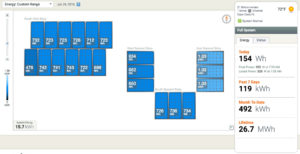Solar panels sit on your roof for decades, silently making electricity from the sun, saving you money and saving the planet a little bit each day. Unfortunately, they’re also silent when they’re not making electricity due to a wiring problem. To make sure your system is working properly, you need a way to check up on them. Solar monitoring systems provide a real-time snapshot of solar energy production data from your solar system. A monitoring system can tell you when one or more panels (aka “modules”) isn’t producing as much energy as others, or whether there’s some sort of electrical fault causing you to miss out on precious kilowatt-hours (kWh). You can use solar monitoring to track your system’s performance over time, assist in troubleshooting various problems, track your solar investment’s financial performance, and give you peace of mind that everything is working as it should. It offers information about energy consumption and generation, optimizing energy usage, and damage to your solar system, among other data.
How does solar monitoring work?
Solar monitoring systems operate through your solar system’s inverter(s). All solar inverters come with a proprietary monitoring software setup. As your solar inverter converts DC current into AC current for use in your home or business, information about power levels and production is collected and sent to cloud-based monitoring systems and their companion apps. You can access this information in several ways, including through mobile apps and paired smart home devices. Some monitoring systems offer on-site monitoring as well, and wire information from the inverters directly to a monitoring device on your property. Most monitoring systems can be set up to have cellular capabilities, which allows you to access system data stored in the cloud from mobile devices without needing to connect to your Wi-Fi network. As a result, if your personal internet connection is lost, you may still be able to access your solar monitoring system. Systems with power optimizers don’t rely on a wireless connection to transmit data, so monitoring continues during internet outages. Depending on the interface you have set up, you may also be able to access your monitoring data even when your internet is down. However, this isn’t the case for micro inverter monitoring systems – they rely on a Wi-Fi connection to monitor each panel individually, in real-time. This means that when the internet goes down, so do your monitoring capabilities. Aside from displaying energy consumption and generation data, monitoring systems offer many tools to help you understand your solar energy setup. Monitoring software can often help detect problems and defects with panels and/or optimizers or micro-inverters in your system. You can also track historical data from your system. For example, monitoring systems offer data on historical weather-based performance, so you can know how the weather has impacted your solar production in the past, and what you might expect in the future.


